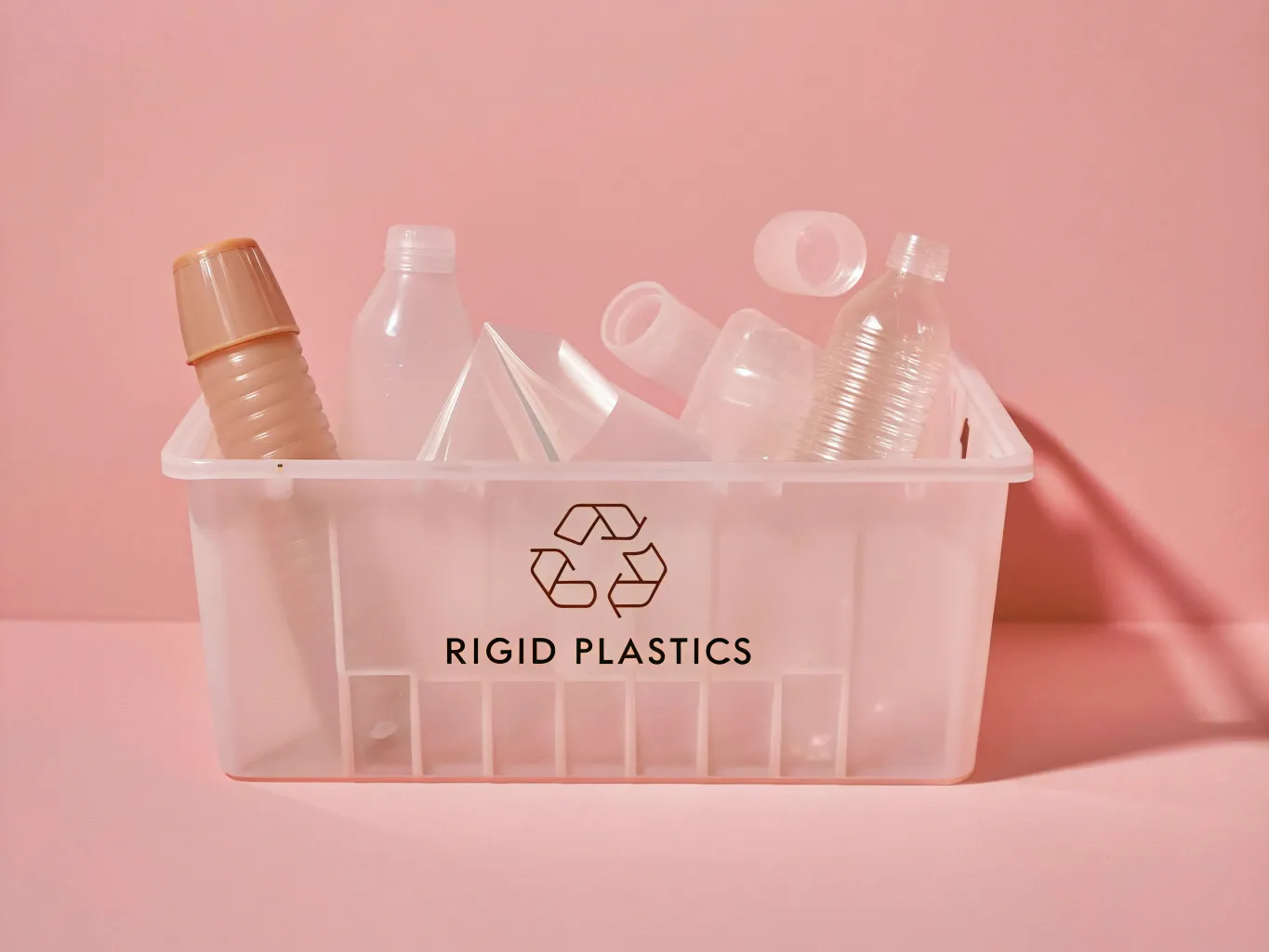Plastics can be categorized in various ways, including by their resin identification code (number) or by their physical properties, such as being rigid or flexible. This article delves into the world of plastiques rigides – materials characterized by their stiffness, structural integrity, and ability to maintain shape under normal conditions. Given their widespread use across numerous industries, understanding the different types of rigid plastics and, crucially, how to effectively recycle them is essential for sustainability.
Common Types of Rigid Plastic
Rigid plastic isn’t a single material but a category encompassing several plastic types. Here are some of the most common:
- Polyvinyl Chloride (PVC): Known for its durability, moisture resistance, chemical resilience, and impact strength, PVC is widely used in construction (pipes, window frames) and electrical applications (conduit).
- Note on Recycling: Recycling PVC presents challenges due to various additives but is feasible. Mechanical recycling is common, often requiring thorough cleaning processes. Effective separation and sorting are vital first steps for successful PVC recycling, often preparing it for processing in specialized lines like a Rigid Plastic Washing Line for PP, HDPE, PVC. Chemical recycling methods are also emerging.
- Polystyrene (PS): This lightweight yet rigid plastic is frequently used for packaging materials (like electronics protection), disposable cutlery, and insulation panels.
- Note on Recycling: Polystyrene recycling faces challenges like low density (especially foams) and contamination sensitivity. The process typically involves compacting foam into denser blocks or melting beads for reuse. While possible, collection and processing require careful handling and clean material streams.
- Polyethylene (PE): While PE comes in various forms, High-Density Polyethylene (HDPE) exhibits notably rigid properties. It’s commonly found in milk jugs, detergent bottles, sturdy containers, and toys.
- Note on Recycling: HDPE recycling is relatively straightforward and highly efficient, making it one of the most widely recycled plastics globally. The process involves collecting, sorting, thorough cleaning (often using a Corde à linge en plastique rigide), melting, and reforming into new items. Its recyclability makes HDPE a prime candidate for effective recycling programs.
- Acrylonitrile Butadiène Styrène (ABS) : ABS is a tough, impact-resistant rigid plastic favoured for automotive parts (dashboards, bumpers), electronic device casings, and durable consumer goods like luggage.
- Note on Recycling: ABS recycling is achievable but can be more complex than for simpler polymers due to its blend composition (Acrylonitrile, Butadiene, Styrene) and potential additives. It involves shredding and melting, but achieving high purity in the recycled material can be challenging.
- Polypropylène (PP) : Another versatile rigid plastic, PP is valued for its strength, chemical resistance, heat tolerance (often microwave-safe), and fatigue resistance. Common uses include food containers, automotive components, medical devices, and reusable crates.
- Note on Recycling: PP (Polypropylene) recycling is generally efficient and relatively simple, placing it among the more easily recyclable plastics. The typical process includes collection, sorting, intensive cleaning in systems like a Rigid Plastic Washing Line for PP, HDPE, and PVC (learn more at: https://www.energycle.com/rigid-plastic-washing-line-for-pp-hdpe-pvc), melting, and transforming into new products such as containers, automotive parts, and textiles. Its recyclability strongly supports circular economy goals.
- Polycarbonate (PC): PC is a high-strength, transparent rigid plastic known for its exceptional impact resistance and clarity. It’s used in eyeglass lenses, safety goggles, electronic device screens, reusable water bottles, and machine guards.
- Note on Recycling: Polycarbonate recycling can be complex due to stringent purity requirements and the presence of additives. Success hinges on meticulous collection, sorting, cleaning, and shredding. Proper preparation is essential for producing quality recycled material suitable for demanding applications.
Why Are Rigid Plastics So Popular?
Several factors contribute to the widespread adoption of rigid plastics:
- Durabilité: They offer a long lifespan and resistance to wear and tear, suitable for demanding applications.
- Versatilité: Moldable into complex shapes and sizes, adaptable across diverse products and industries.
- Rentabilité : Often economical to manufacture compared to materials like metal or glass.
- Résistance chimique : Many types resist chemicals, moisture, and weathering, ideal for harsh environments or storing various substances.
- Recyclabilité : Key rigid plastics like HDPE and PP are highly recyclable, supporting sustainability goals. Effective recycling, however, relies on robust collection systems and advanced processing technologies, including Rigid Plastic Recycling Machines like specialized washing lines, to ensure materials are properly cleaned and prepared for reuse, minimizing environmental impact.
- Léger: Despite their strength, most rigid plastics are relatively lightweight, beneficial in automotive, aerospace, and portable product applications.
- Personnalisation : Can be engineered with specific colours, textures, UV resistance, and other properties.
These attributes make rigid plastics a preferred material choice for a vast array of consumer and industrial goods.
Examples of Rigid Plastic Products
Rigid plastics form countless everyday items. Here are a few examples highlighting their properties:
- Plastic Bottles (HDPE): Strong, chemically resistant, lightweight, and highly recyclable. Ideal for milk, juice, detergents, and shampoos.
- Plastic Window Frames (PVC): Weather-resistant, durable, provide good thermal insulation, and require minimal maintenance.
- Plastic Food Containers (PP): Versatile, often microwave-safe, stain-resistant, and easily recyclable, making them excellent for food storage.
- Plastic Cutting Boards (HDPE or PP): Hygienic (easy to clean, non-porous), durable, and won’t dull knives quickly. Recyclable, though sometimes require specialized collection.
- Plastic Automotive Parts (ABS, PP): Impact-resistant (bumpers, trim), lightweight (improving fuel efficiency), and easily molded into complex interior and exterior components. Recycling contributes to automotive sustainability.
- Plastic Electronics Casings (ABS, PC): Provide protection, can be transparent (PC for screens), lightweight, and allow for intricate designs. Recycling these materials supports e-waste management efforts.
Industrial Forms of Rigid Plastics
Beyond finished products, rigid plastics are often supplied as semi-finished industrial materials like plates and sheets for further fabrication. Examples include:
- Methacrylate (Acrylic/PMMA) Sheets: Used for signs, displays, glazing, and applications needing transparency or translucency.
- Mirror Acrylic Sheets: Lightweight, shatter-resistant alternatives to glass mirrors for decorative and safety applications.
- Polycarbonate Sheets: High impact resistance and clarity make them suitable for safety glazing, machine guards, and greenhouse panels.
- Polypropylene Sheets: Versatile sheets used in packaging, automotive parts, chemical tanks, and industrial equipment.
- PVC Sheets: Valued for chemical resistance and durability in construction, signage, tank lining, and fabrication.
- Foamed PVC Sheets: Lightweight yet rigid, used in signage, displays, and construction mounting boards.
- PETG Sheets: Clear, impact-resistant sheets used for point-of-purchase displays, medical device packaging, and machine guards.
- ABS Sheets: Impact-resistant and easily formable, used for automotive interiors, luggage shells, and electronic enclosures.
Conclusion
In summary, rigid plastics offer remarkable versatility and durability across countless applications. While their properties make them invaluable, responsible end-of-life management through effective recycling is paramount. Technologies like advanced Rigid Plastic Recycling Machines, including specialized cordes à linge specifically designed for materials like PP, HDPE, and PVC, play a vital role in cleaning and preparing these plastics for reprocessing, enabling a more circular economy and reducing environmental impact.



